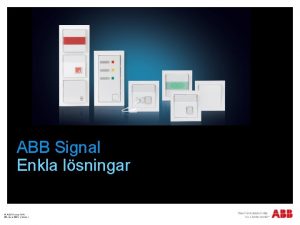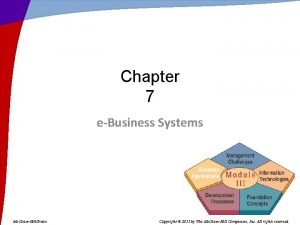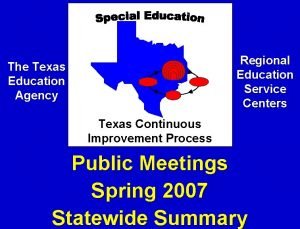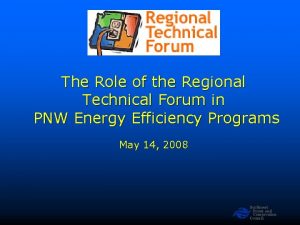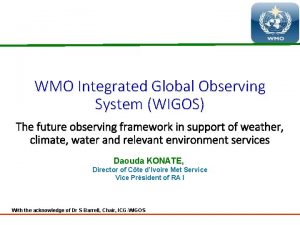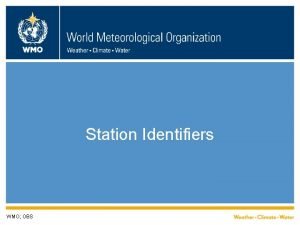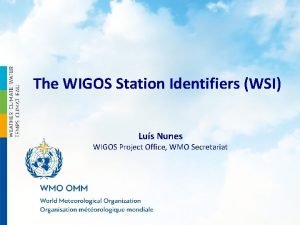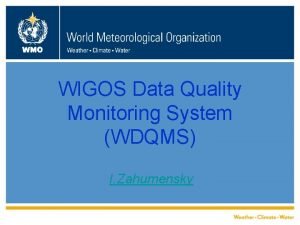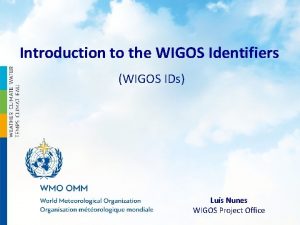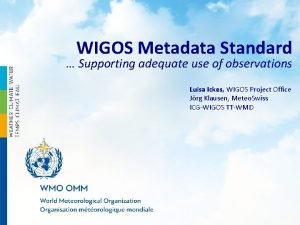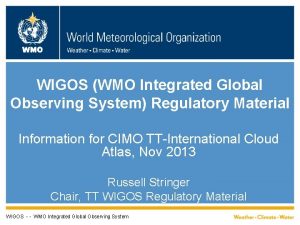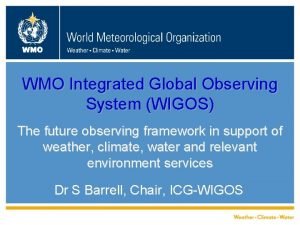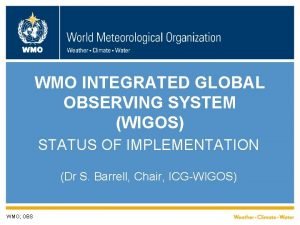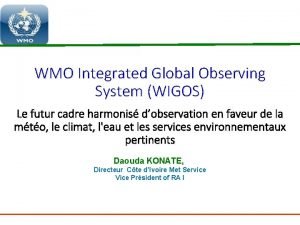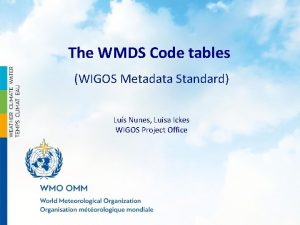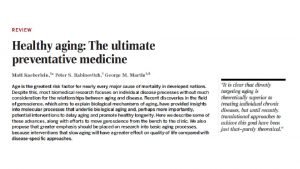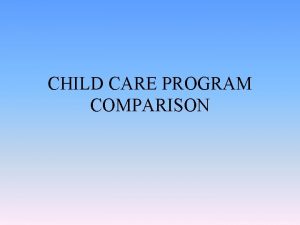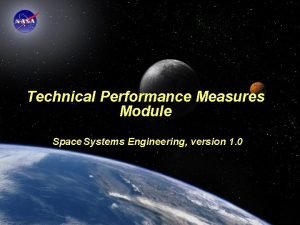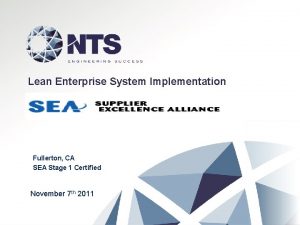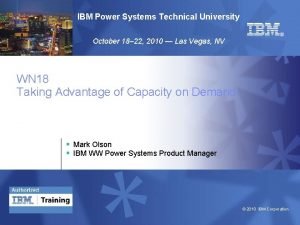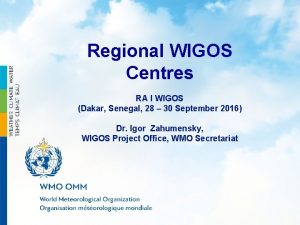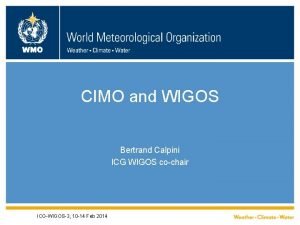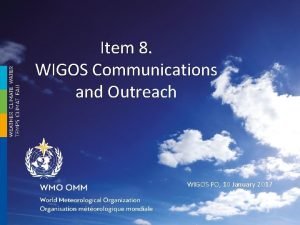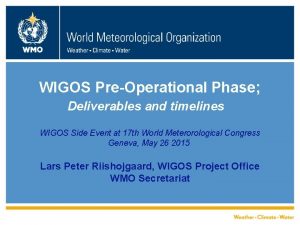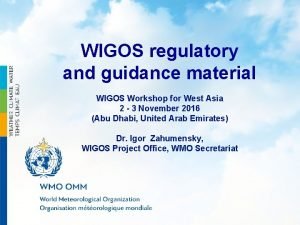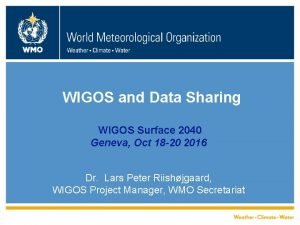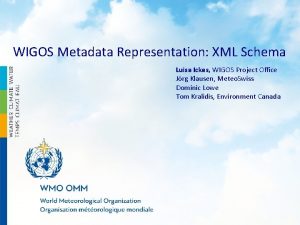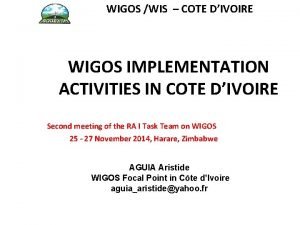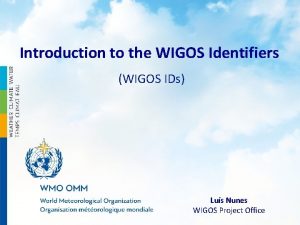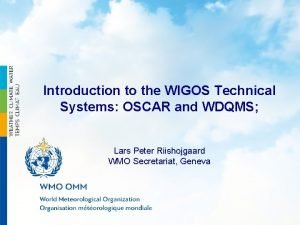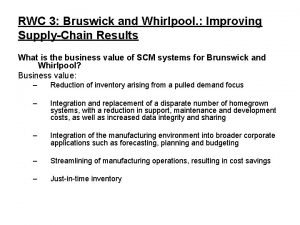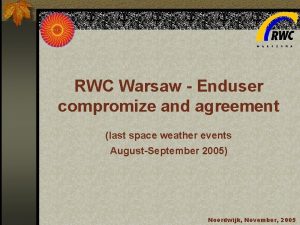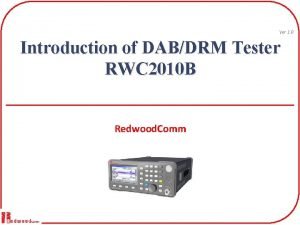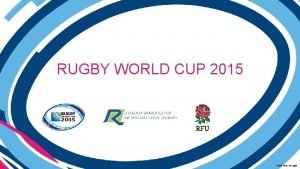Regional WIGOS Centers RWC and WIGOS technical Systems
























- Slides: 24

Regional WIGOS Centers (RWC) and WIGOS technical Systems (OSCAR/Surface and WDQMS) Lars Peter Riishojgaard and Luis Nunes WMO Secretariat, Geneva

Outline • WMO Introduction to Regional WIGOS Centers • OSCAR/Surface • WIGOS Data Quality Monitoring System (WDQMS) • Conclusions RA-II Workshop on WIGOS, Beijing, November 6 -8 2018

Outline • WMO Introduction to Regional WIGOS Centers • OSCAR/Surface • WIGOS Data Quality Monitoring System (WDQMS) • Conclusions RA-II Workshop on WIGOS, Beijing, November 6 -8 2018

Introduction to RWCs • Regional WIGOS Centres (RWCs) will play a critical role in advancing operation of WIGOS. • The overall purpose of the RWCs is to provide support and assistance to WMO Members and Regions for their national and regional WIGOS implementation efforts. • The RWCs will work closely with: – – – WMO Regional Offices RICs, RRCs, RMICs RTCs RA I MG & WG-OTI Members WIGOS-PO

Mandatory functions 1. Regional WIGOS metadata management – work with data providers to facilitate collecting, updating and providing quality control of WIGOS metadata in OSCAR/Surface; 2. Regional WIGOS performance monitoring and incident management (WIGOS Data Quality Monitoring System) – and follow-up with data providers in case of data availability or data quality issues (WDQMS);

Optional Functions • Assistance with the coordination of regional/subregional and national WIGOS projects; • Assistance with regional and national observing network management; and • Support for regional capacity development activities. • …

Implementation Options • Each RA (i. e. Members of the Region) must decides on its own way to address specific needs, priorities, challenges and available technical and human resources of the Region; • Member or group of Members can establish RWC in subregion, taking into account the natural geographic / linguistic / economic conditions/circumstances of the sub region.

Establishing a Regional WIGOS Centre in pilot mode (Annex to Decision 30, EC-69) 1. 2. 3. 4. 5. 6. 7. 8. Introduction Rationale for the project and its relevance to WMO Project description Resourcing Implementation stages Risk assessment/management Governance, management and execution Monitoring and evaluation Annex 1 - Concept note on establishment of WMO Regional WIGOS Centres Annex 2 - Application template for a RWC candidate

Current status of RWCs • Region I: Many indications of national interest (e. g. Morocco, Kenya, Tanzania, …; limited national resources. RWC pilot to be initiated in East Africa on DFID (UK) project funding, centered in Kenya and Tanzania • Region II: on a sub-regional basis: China and Japan have both formally addressed P/RA-II to request recognition of RWCs in pilot mode in Beijing and in Tokyo, respectively; Indications of interest also from Saudi Arabia and India. • Region III: Plans for Virtual RWC maturing, with distributed functions involving 3/4 Members, decision to be made at RA-III-17 later this month; • • Region IV: No clear path yet; USA may be willing to help; • Region VI: successful RWC operating in pilot mode at DWD thanks to EUTMETNET engagement; see presentation by Stefan Klink; tentative plans for RWCs also in Belarus (Russian-speaking countries in RA-II and RA-VI) and Croatia (specifically for marine observing systems). Region V: Indications of interest from Australia, Fiji, Indonesia, Singapore; was discussed at RA-V-17 in October; RA-II Workshop on WIGOS, Beijing, November 6 -8 2018

Outline • WMO Introduction to Regional WIGOS Centers • OSCAR/Surface • WIGOS Data Quality Monitoring System (WDQMS) • Conclusions RA-II Workshop on WIGOS, Beijing, November 6 -8 2018

OSCAR/Surface (“What is WIGOS? ”) Implementation layer of the WIGOS Metadata Standard: Modern, electronic, searchable inventory of metadata for all observing stations/platforms under WIGOS • OSCAR/Surface will replace WMO Pub. 9, Volume A, but will also include information from similar inventories for other (non-GOS) components of WIGOS • Developed jointly by WMO and Meteo. Swiss, with the Swiss government providing the major part of the funding • Operational since May 2016 • Education and training Members in populating, editing and using OSCAR/Surface is a major priority for 2016 -2019 financial period; Training delivered in • • • RA I (English); RA III (Spanish); RA IV (Spanish and English); RA V (English); RA VI (English)


The OSCAR/Surface webinar I. III. IV. V. VI. Monthly webinar with varying topic, since Sept 2018 Audience is OSCAR/Surface Focal Points and users Always on the first Monday of the month 11 UTC Hosted on the WMO Webex platform More info and recordings of past webinars on OSCAR/Surface Resources Portal We are open for suggestions on topics!

The OSCAR/Surface API (Application Programming Interface); Machine to Machine (M 2 M) updating of OSCAR I. Release 1. 4. 1 (September 2018) first version of API I. II. Manual upload only Based on 1. 0 RC 9 WMD schema Release 1. 4. 2 (October 2018) brought additional features I. III. Authentication token Upload to proper REST API endpoint XML download

The OSCAR/Surface API (II – Usage) I. II. Obtain access to OSCAR/Surface API NFPs can create machine user and obtain security token Security token needed to access API II. Encode station fully or partly in WMD XML III. Send WMD XML file (and token) to the API endpoint I. II. XML is first validated, only valid XML files are processed New station is created if station does not exist yet (WIGOS ID) III. Station is updated if already existing I. II. Add information if it does not exist already (gml id) Correct information if it exists already (gml id) IV. Process status code to know if update succeeded

The OSCAR/Surface API (III - Use cases) I. II. Synchronize OSCAR/Surface with a local database I. III. Regular process For countries with existing station database Integrate into data warehouse workflow Upload list of stations to OSCAR/Surface I. III. Initial seeding Import stations from Excel etc. lists One-time action III. Interactive and semi-automatic batch changes I. I. II. Make batch correctionss adding observations Correcting schedules Semi-automatic and interactive usage

API documentation • the OSCAR/Surface Resources Portal • Formal model and XML schema are on http: //schemas. wmo. int • Current version: 1. 0 RC 9 (http: //schemas. wmo. int/wmdr/1. 0 RC 9/) • Codelist entries for XML elements are important – http: //test. wmocodes. info/wmdr/ – More code lists on gdrive • OSCAR/Surface User Manual (soon)

Outline • WMO Introduction to Regional WIGOS Centers • OSCAR/Surface • WIGOS Data Quality Monitoring System (WDQMS) • Conclusions RA-II Workshop on WIGOS, Beijing, November 6 -8 2018

The WIGOS Data Quality Monitoring System (“How is WIGOS performing? ”) • One of the five priority areas of WIGOS Pre-operational phase: Describes how well WIGOS is functioning • Real-time monitoring of performance – data availability (implemented) and quality (under development), – searchable by region, country, station type, period, etc. – for all WIGOS components (GOS, GAW, WHOS, GCW, GCOS), • Evaluation of monitoring results • Incident management component for mitigation of issues • Current/recent activities: – Pilot project on NWP-based monitoring: ECMWF, NCEP, DWD, JMA – RA-I Demonstration Project of monitoring and incident management involving Kenya and Tanzania running through Jun. 2016 -Jun. 2017

The Pilot project with Global NWP Centres (1) • Four NWP centers, ECMWF, NCEP, JMA, DWD, are providing monitoring output in real time (every six hours) to WMO Secretariat; • Started with surface pressure, now including also surface humidity, wind, temperature and upper air soundings • Simple ASCII files in commonly agreed format contain the following information for each individual observing station: – – Observation received within operational data cut-off (yes/no) Observation used in assimilation (yes/no) If not used, why not (flag) Observation minus background residual (value) • The Task Team on WDQMS and NWP centres are working to expand the monitoring to other observation types (marine, aircraft, climate)

The Pilot project with Global NWP Centres (2) • A prototype of a Webtool for displaying the monitoring outputs from the NWP Centres was developed at Secretariat (WIGOS PO) – Interactive geographic display – Interactive time series graphics • Data quality: – Data quality monitoring is being developed to compare with O-B values – Implementation of data quality monitoring in the Webtool not ready • ECMWF agreed to host, to further develop and to implement the operationally

Technical Guidelines for RWCs on the WDQMS for surface land stations of the GOS (part of Guide to WIGOS) 1. 2. 3. 4. Functions of a WDQMS for surface-based system of GOS WDQMS Quality Monitoring Practices Data quality monitoring and evaluation Incident Management Procedure 4. 1 Responsibilities 4. 2 Steps of the Incident Management Procedure 4. 2. 1 4. 2. 2 4. 2. 3 4. 2. 4 4. 2. 5 4. 2. 6 4. 2. 7 Issue Identification (A) Issue Raised as Incident (Process Initiation) (B) Receipt Confirmation (C) Action Proposal (D) Incident Status (E) Confirmation of Successful Incident Rectification (F) Incident Escalation Procedures 5. Quality Performance Reports

Summary and Conclusions • WIGOS Pre-operational Phase 70% completed; main technical systems implemented/under implementation; • Already providing powerful diagnostics of the workings of WIGOS/WIS and the compliance of WMO Members with WMO regulatory and guidance material; • Room for very substantial improvement! • This is a limiting factor in the quality of monitoring, forecast and warning products; • Regional WIGOS Centers are a key element in supporting Members in the implementation of WIGOS and in improving the overall performance of WIGOS; • RA-VI pioneered the RWC implementation, but is still looking for a way forward to make this operational RA-II Workshop on WIGOS, Beijing, November 6 -8 2018

Thank you lfnunes@wmo. int www. wmo. int/wigos
 Rwc larm regler
Rwc larm regler Rwc intranet
Rwc intranet Rwc
Rwc Workforce transformation opwdd
Workforce transformation opwdd Texas regional education service centers
Texas regional education service centers Regional technical forum
Regional technical forum Wigos system
Wigos system Wigos station identifier
Wigos station identifier Wigos station identifier
Wigos station identifier Wigos data quality monitoring system
Wigos data quality monitoring system Wigos station identifier
Wigos station identifier Wigos metadata standard
Wigos metadata standard Wigos system
Wigos system Oswigos
Oswigos Oswigos
Oswigos Wigos
Wigos Wigos metadata standard
Wigos metadata standard List of nih institutes
List of nih institutes Global marketplaces and business centers
Global marketplaces and business centers Centroids and centers of gravity
Centroids and centers of gravity Laboratory schools advantages and disadvantages
Laboratory schools advantages and disadvantages Health resource centers and libraries near pittsburg
Health resource centers and libraries near pittsburg Technical performance measures systems engineering
Technical performance measures systems engineering National technical systems fullerton
National technical systems fullerton Ibm power systems technical university
Ibm power systems technical university
